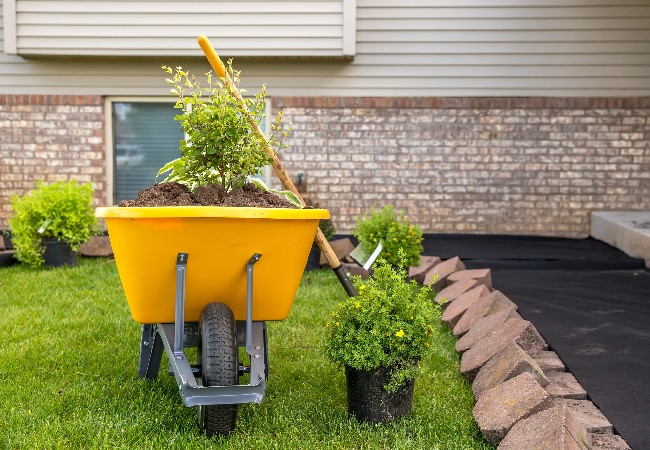

We may earn revenue from the products available on this page and participate in affiliate programs. Learn More ›
For those who lead active lives, spending a few weekend hours pulling or digging weeds out of a garden, flower bed, or raised bed can quickly become tedious. There are a number of weed-control methods that can make a gardener’s life easier, and the use of landscape fabric is at the top of that list.
Whether you’re new to gardening or have been at it so long your thumb is a deep shade of green, you may have seen rolls of this material at DIY stores and gardening centers—and become intrigued. Satisfy your curiosity with our crash course in landscape fabric, which is designed to inhibit weeds and keep soil from drying out. Among its many benefits, landscape fabric helps control weeds without the use of potentially toxic chemicals. Here, we’ll clue you in on its pros and cons, explain how to pick the best type for your situation, and share tips for using it most effectively.
1. Landscape fabric is also known as weed fabric, garden fabric, and landscape cloth.
Landscape fabric is constructed from woven fibers or manufactured as a solid sheet with perforated holes to allow water to soak through. Some brands offer UV protection to maintain the life of the fabric. It comes in rolls that are typically at least 3 feet wide and anywhere from 50 feet to 200 feet (or more) long. Note that virtually all landscape fabric can be covered with mulch of any type—wood chips, gravel, recycled rubber nuggets, and so on. Landscape fabric under gravel works especially well because the weight of the gravel helps hold the fabric in place.
2. It is often used as a natural alternative to chemical herbicides.
Landscaping fabric can prevent weed seeds buried in the soil from sprouting, and it limits the necessity of using herbicides for weed control. Seedlings need light and air to grow, so when weed seeds germinate under a layer of landscape fabric, they are blocked from reaching the sun’s rays, and die as a result.
Many gardeners are reluctant to treat their borders and flower beds with chemical herbicides, especially if they have pets or children who play in the yard. Landscape fabric allows gardeners to reduce or eliminate the use of chemical herbicides.
3. Landscape fabric pins hold the cloth in place.
Sometimes called “landscape staples,” these stiff, U-shaped wires are hammered through landscape fabric into the soil with an actual hammer or a rubber mallet to “pin” the fabric down. They’re usually 4 to 6 inches long and about an inch across, and they’re made of 11-gauge wire. While the wood chips, gravel, or other type of mulch you ultimately lay over the fabric will help hold it in place, it’s a good idea to use the pins if it’s windy or if you’re having to cut and arrange oddly shaped pieces of fabric around existing plants.
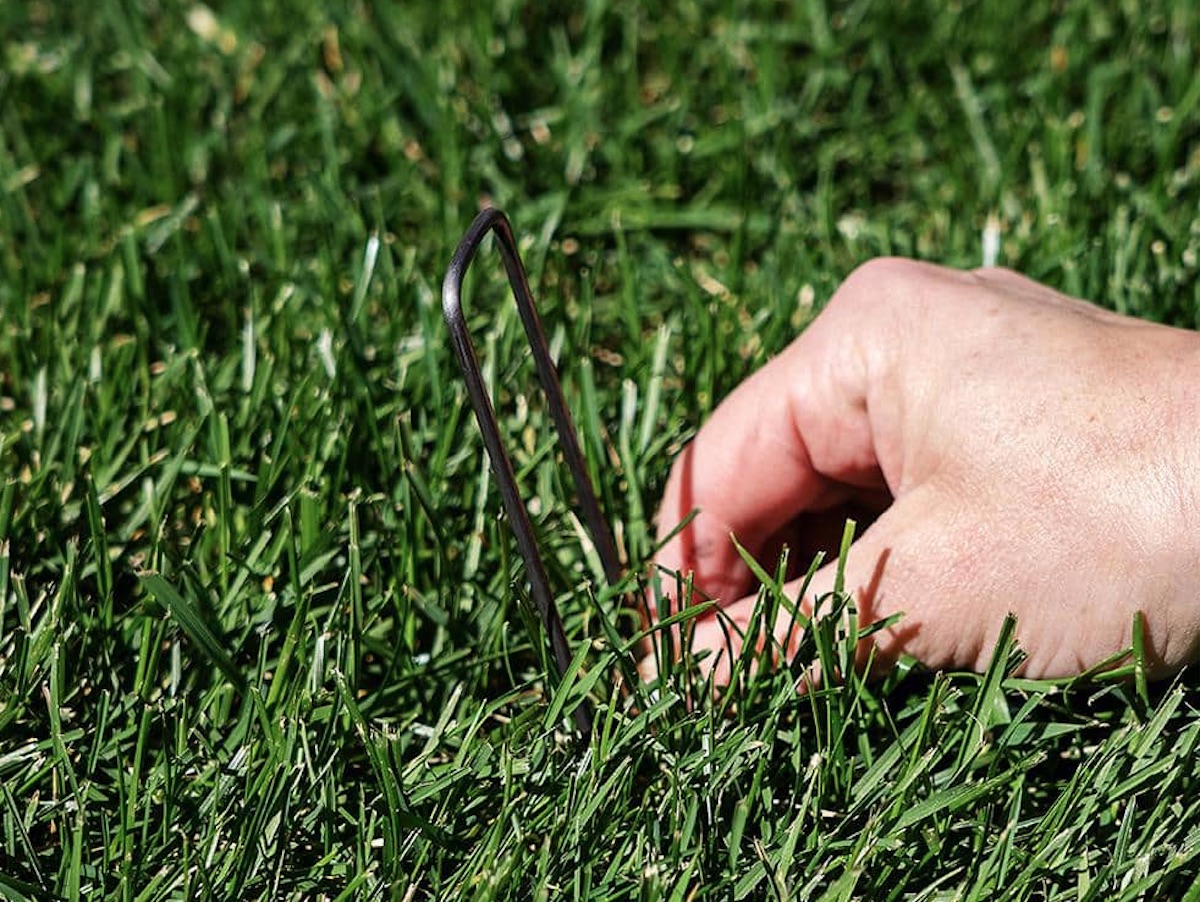
4. The one-time cost of landscaping fabric and pins is relatively low compared to paying for ongoing weed control.
The cost of landscape fabric varies from around 45 cents per square foot to 80 cents per square foot, depending on the brand and thickness. Thicker fabric typically runs a bit more. Experienced gardeners recommend springing for professional-quality landscape fabric because it does a better job of weed control than some of the lower-cost options.
You’ll need landscape pins, which sell separately for 10 cents to 20 cents per pin and are necessary to secure the fabric. These can add another 50 cents per square foot to your total material cost, depending on how many you use.
Ongoing weed control, on the other hand, requires the purchase of seemingly endless containers of weed killer and an equally endless amount of effort to hand-pull ever-returning weeds.
5. Besides keeping weeds at bay, garden fabric is also useful in DIY erosion control.
An added benefit of landscape fabric is that it helps prevent erosion on slopes. Note that when installing landscape fabric on a slope, you will have to be fairly generous with the number of pins you use to secure it.
Beyond weed control, landscape fabric:
- Keeps inorganic mulches and unwanted debris like rocks from settling into the soil. While mulches such as chipped and shredded, recycled rubber offer aesthetic value when layered around the bases of trees and shrubs, they do not decompose. A layer of landscape fabric can keep them from sinking into the soil, where they would be difficult to remove.
- Helps retain soil moisture by reducing evaporation. Sun and wind are significant contributors to evaporation, which can leave the soil dry. Laying landscape fabric on top of the soil will help keep moisture in the ground.
- Offers some erosion control on slopes that are subject to washout from heavy rains. Semipermeable landscape fabrics allow some moisture to seep through while protecting the surface of the soil from water that runs downslope, which can cause erosion.
6. Installing a weed barrier may create more work for you down the road.
Some gardeners refuse to use landscape fabric because:
- It discourages garden-friendly earthworms that need to reach the soil surface to survive. Earthworms aerate the soil. Without them, the ground beneath landscape fabric can become compact and unhealthy.
- Reseeding is almost impossible. Gardeners and landscapers who depend on desirable plants spreading naturally by reseeding will be disappointed if they use landscape fabric. Seeds that fall neither penetrate the fabric nor sprout.
- It can be a pain to remove later. Once landscape fabric is in place, it’s usually covered with rocks, or rubber or wood chips. To remove or replace the material, all the chips or rocks must first be shoveled or raked away.
7. It won’t prevent weeds from growing in the soil medium you use to cover the fabric.
The purpose of landscape fabric is to control weeds. It’s bound to do its job effectively for the first year or two, but be prepared to pull weeds that may sprout on top of the fabric later. While the fabric blocks seeds beneath it from sprouting, new seeds can blow in and—depending on the type of fabric—their roots can adhere tightly to the perforations, making it difficult to pull them out without pulling up the fabric with them. This is especially true if you use organic mulch, such as wood chips, which will eventually degrade and become a plant-growing medium on top of the fabric.
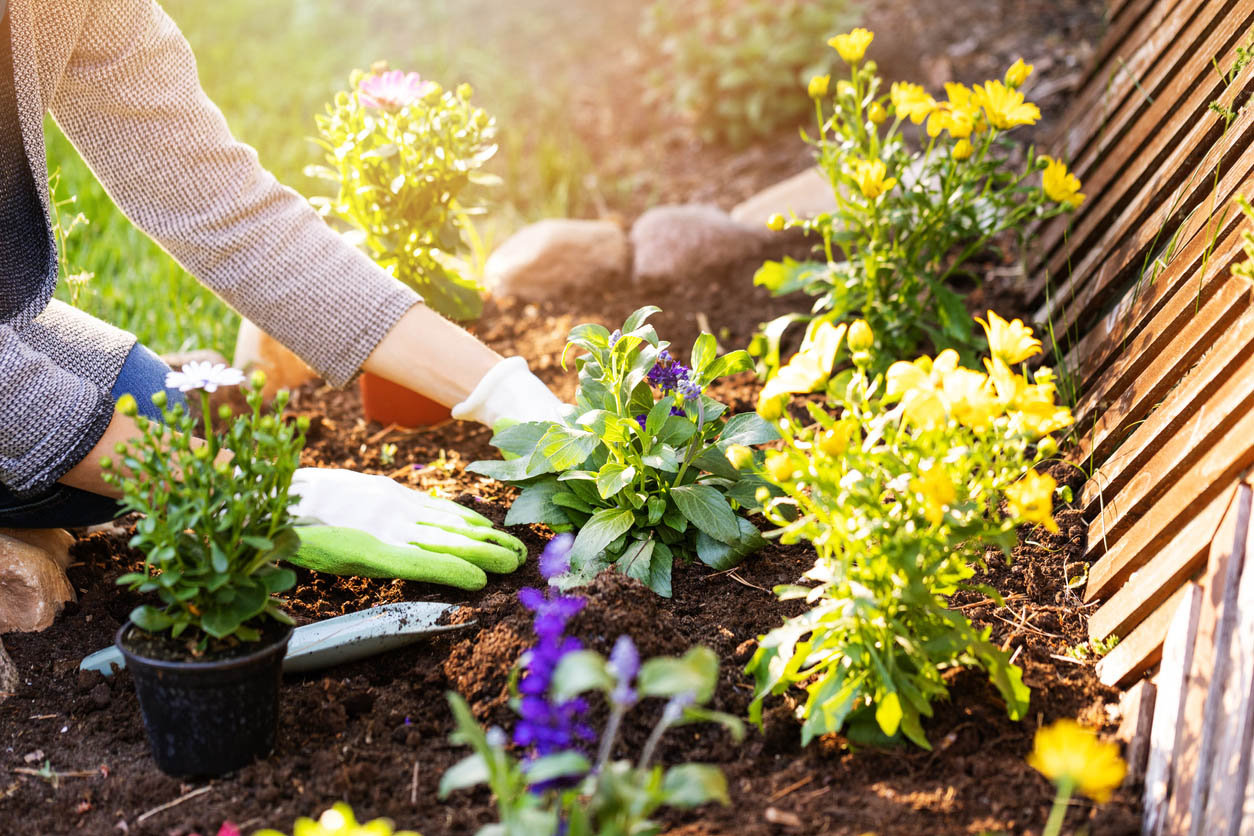
8. Make sure to choose the right type of landscaping fabric for your intended use.
The quality of the landscape fabric, together with sound installation practices (discussed below), will determine how long it will hold up. Still, it’s not a miracle product. Cheap stuff rips easily and might not last a single season.
How can you identify a high-quality roll of landscape fabric? Start by checking its weight and thickness: A 150-square-foot roll that weighs 20 pounds is going to be made of thicker, heavier fabric than a roll of the same square footage that weighs only 10 pounds. If you’re unsure, ask a reputable garden center to recommend their best garden fabric.
Generally, Scotts landscape fabric, which is available at most home centers and online, meets the requirements of the typical homeowner. Individual gardening and landscaping needs vary, so it’s essential to choose the landscape fabric that best suits the task at hand.
9. Add amendments to your soil before covering it with garden cloth.
Keep in mind that natural organic mulch, such as fallen leaves or pine needles, cannot replenish nutrients in the soil below a layer of landscape fabric. Without fabric in the way, this type of organic matter would naturally biodegrade and eventually blend with the soil, amending it with rich nutrients. For this reason, make sure to add composted manure, peat moss, and other types of organic matter to your soil before installing landscape fabric—because, obviously, you can’t add them later. If you’re unsure of which amendments to add, take a soil sample to your local extension office, a county office that performs soil testing (usually for a fee) in addition to providing residents with expert agricultural and gardening information.
10. When prepping for your garden project, don’t skimp on landscape fabric. 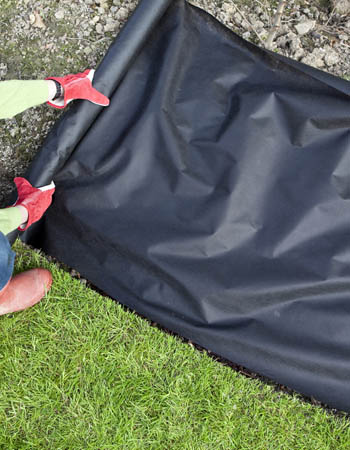
Mother Nature is relentless, and as you know if you’ve ever seen a plant growing through a minuscule crack in a sidewalk, she will find a way to procreate in virtually any circumstance. Weeds will wend their way up, over, and around the edges of landscape fabric if you don’t take care to generously overlap the pieces.
After measuring the area you plan to cover with fabric, plan at least 8 inches of overlap where edges of the landscape fabric meet, and allow a 2-inch overhang of fabric around the perimeter. You can tuck it under later when the rest of the fabric has been secured. In fact, as landscaped beds typically have a border, you should be able to tuck the excess fabric neatly along the perimeter by pushing it down between the soil and the border with a putty knife, effectively concealing it.
11. Aren’t sure how to use landscape fabric? It’s pretty easy to install.
- Level the soil. After adding amendments and working them into the soil thoroughly, level the terrain by breaking up hard clods and raking the surface smooth.
- Lay out the fabric with the rough side facing downward. This helps the fabric stay in place while you’re working.
- Pin the fabric securely. Insert a landscape pin every 8 to 10 inches along the edges of the fabric and 12 inches apart within the center of the fabric. Don’t skimp on pins, or fabric could come loose in a month or two.
- Cut round holes for inserting landscape plants, using a very sharp utility knife. Make sure holes are large enough to plant the specimens you select.
- Cover the landscape fabric with 2 to 3 inches of mulch. This layer assists the pins in holding it down, protects it from UV rays, and helps the ground beneath the fabric retain moisture. Plus, mulch adds a beautiful finishing touch to the landscaping!
12. Planting ground cover is the most natural alternative to landscape fabric.
If landscape fabric doesn’t appeal to you, natural options for weed control include planting a thick and quick-growing ground cover. Nothing could be more natural than using a spreading ground cover in perennial beds and borders to reduce weeds. Varieties such as ajuga and creeping juniper will spread out and form dense green mats that help to choke out weeds. But don’t expect ground cover to be a foolproof panacea for your weed problem. These persistent buggers almost always seem to find a way to pop up where you don’t want them.
13. There are a number of landscape fabric alternatives that also serve as effective weed barriers.
Landscape fabric isn’t the only weed-blocking material. Some gardeners want a simpler, less time-consuming solution than laying out the fabric, measuring it, cutting it, and then positioning it and pinning it in place. Others are looking for the most environmentally friendly option they can find. Here are some popular alternatives to landscape fabric and why gardeners use them:
- Newspaper: Printed newspapers are quickly becoming things of the past, but for those who still have subscriptions, using the old newspapers as weed-blockers is an excellent way to recycle while deterring weeds. Spread out 5 to 8 layers of newspaper around plants in the vegetable garden or flower bed and then dampen to hold them in place. Lay down more sheets periodically as the previous sheets decompose and add useful nutrients to the soil.
- Burlap: Old burlap sacks can be cut and repurposed as weed-barrier fabric around the bases of plants and shrubs. Burlap features an open weave that allows air and water to filter through while helping the soil retain moisture and block weeds.
- Cardboard: Like newspapers, cardboard will biodegrade and enhance the soil. Plus, cardboard is usually dirt cheap and can be cut from boxes that are no longer needed.

14. Choose wisely when deciding between plastic ground cover and biodegradable landscape fabric.
Plastic doesn’t decompose as many landscape fabrics are designed to do after a few years, so it must be physically removed. Still, plastic has its place in the landscape—for instance, when you’re installing paver or cobblestone walkways. Laying plastic landscape sheeting right above the soil will prevent weeds from growing between the stones. In flower beds and other garden areas where plants need air to survive and thrive, permeable landscape fabric is the better option.
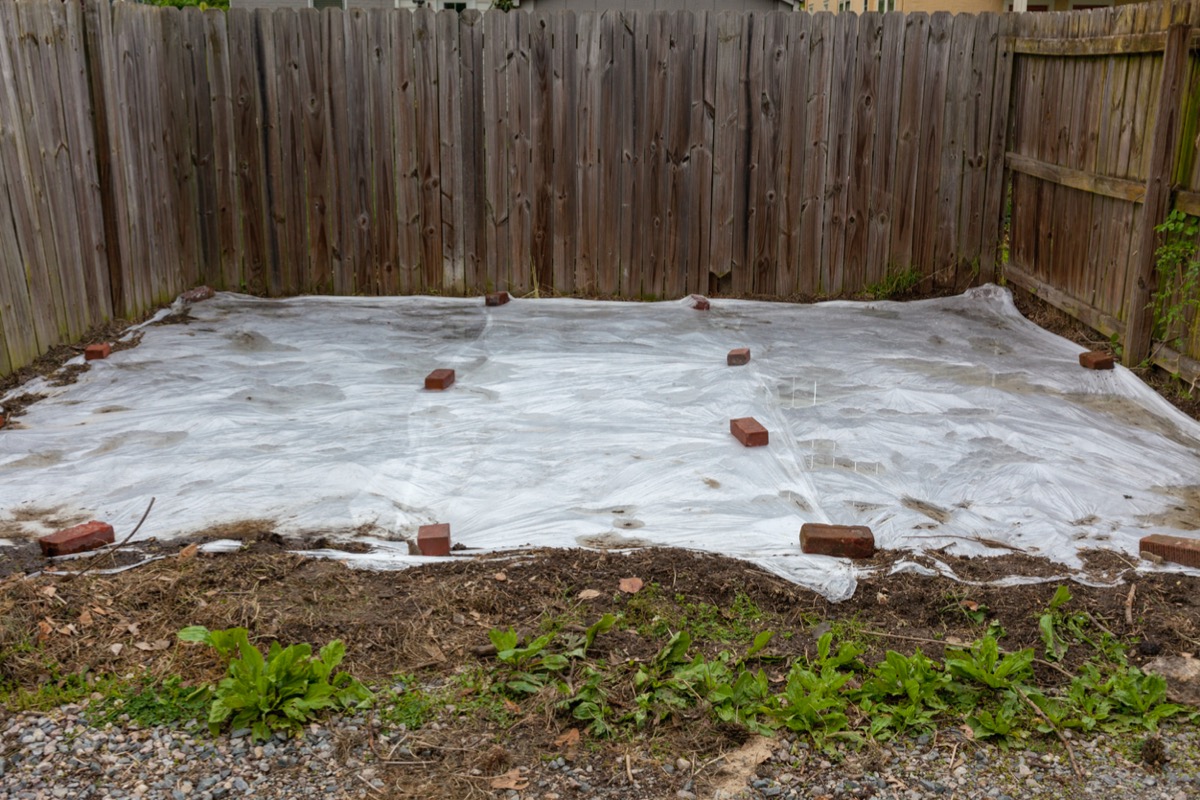
15. Maintain the mulch, soil, or rock layer above the fabric to keep weeds out over time.
You may wish to apply a pre-emergent herbicide like Preen on top of the mulch at the start of every new growing season to help prevent blown-in seeds from sprouting. Pre-emergent herbicides are designed to be applied to soil after desirable plants are already established and won’t harm those established plants. While it won’t kill existing weeds, a pre-emergent herbicide will keep new weed seeds from sprouting.
Also, keep an eye on whatever type of mulch you’ve layered on top of the landscape fabric. As the seasons pass, you’re bound to lose some of that coverage to weather, wind, foot traffic, and so on. Plan to assess at least annually and add additional mulch or gravel as needed.
Final Thoughts
With today’s busy lifestyles, many gardeners don’t have hours each week to dedicate to keeping flower beds and landscaped rock gardens weed-free. Using a quality weed-control fabric can greatly reduce weeding chores, and the material has the added benefit of keeping moisture in the soil, which also goes a long way toward conserving water.
